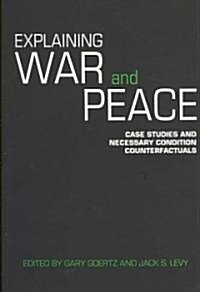
Explaining war and peace: case studies and necessary condition counterfactuals
- 발행사항
- London ; New York : Routledge/Taylor & Francis Group, 2007
- 형태사항
- xv, 346 p. : illustrations; 24 cm
- ISBN
- 9780415422338
- 청구기호
- 392.1 G597e
- 서지주기
- Includes bibliographical references (pages 317-339) and index
소장정보
| 위치 | 등록번호 | 청구기호 / 출력 | 상태 | 반납예정일 |
|---|---|---|---|---|
이용 가능 (1) | ||||
| 1자료실 | 00018637 | 대출가능 | - | |
- 등록번호
- 00018637
- 상태/반납예정일
- 대출가능
- -
- 위치/청구기호(출력)
- 1자료실
책 소개
This edited volume focuses on the use of ‘necessary condition counterfactuals’ in explaining two key events in twentieth century history, the origins of the First World War and the end of the Cold War.
Containing essays by leading figures in the field, this book analyzes the causal logics of necessary and sufficient conditions, demonstrates the variety of different ways in which necessary condition counterfactuals are used to explain the causes of individual events, and identifies errors commonly made in applying this form of causal logic to individual events. It includes discussions of causal chains, contingency, critical junctures, and ‘powder keg’ explanations, and the role of necessary conditions in each.
Explaining War and Peace will be of great interest to students of qualitative analysis, the First World War, the Cold War, international history and international relations theory in general.
This edited volume focuses on the use of ‘necessary condition counterfactuals’ in explaining two key events in twentieth century history: the origins of the First World War and the end of the Cold War.
목차
1. Introduction 2. Causal Explanation, Necessary Conditions, and Case Studies 3. The Role of Necessary Conditions in the Outbreak of World War I 4. Contingency, Catalysts and Non-Linear Change: The Origins of World War I 5. Powder Kegs, Sparks and World War I 6. Necessary Conditions and World War I as an Unavoidable War 7. Power, Globalization, and the End of the Cold War: Reevaluating a Landmark Case for Ideas 8. Perestroika without Politics: How Realism Misunderstands the Cold War’s End 9. New versus Old Thinking in Qualitative Research 10. Conclusions

